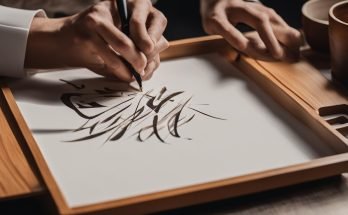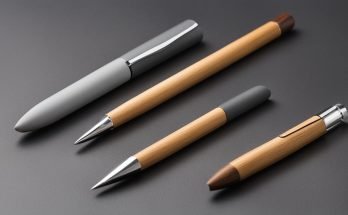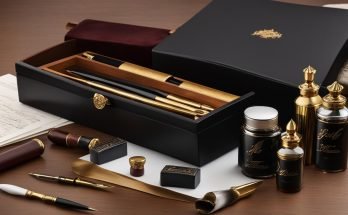Calligraphy Set Maintenance: Discover the Secrets to Keeping Your Tools Pristine
Proper care and maintenance of your calligraphy set are essential for preserving its performance and longevity. With regular cleaning and attention to detail, you can ensure that your tools are always in pristine condition. By following these simple tips, you’ll be able to enhance your artistic skills and enjoy the art of calligraphy to the fullest.
Key Takeaways:
- Regular maintenance is necessary to keep your calligraphy set in optimal condition.
- Cleaning your nibs is crucial for maintaining good ink flow and preventing clogs.
- Adjusting the consistency of your ink can enhance your writing experience.
- Choosing the right paper can greatly impact the quality of your calligraphy.
- Proper storage is essential for preventing damage to your calligraphy set.
The Importance of Cleaning Your Nibs
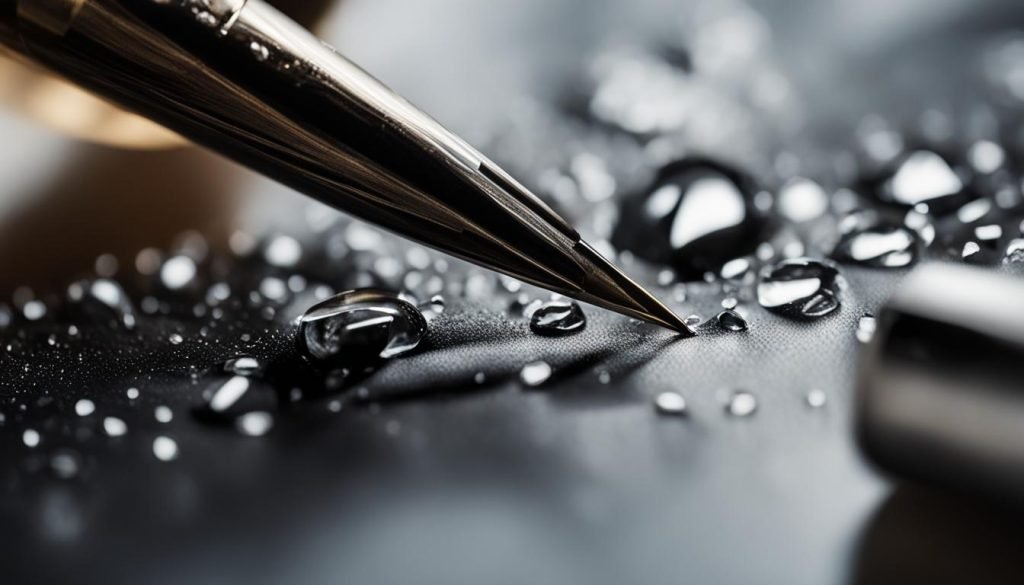
Cleaning your nibs is an essential part of maintaining your calligraphy set and ensuring optimal performance. Neglecting to clean your nibs can lead to poor ink flow, clogs, and an overall frustrating calligraphy experience. Properly cleaning your nibs is easy and can be done using a few different methods.
When you first purchase a new nib, it’s important to remove the protective coating that often comes with it. This can be done by wiping the nib with rubbing alcohol or using non-abrasive toothpaste and a soft toothbrush. Gently scrub the nib to remove any residue and ensure that it is ready for use.
To clean your nibs on a regular basis, you have several options. One method is to pass the nib through a flame, such as from a lighter or candle. The heat will burn off any dried ink and help keep the nib clean. Another option is to immerse the nib in boiling water for a few seconds. This can help loosen any stubborn dried ink, making it easier to clean.
“Properly cleaning your nibs is easy and can be done using a few different methods.”
Additionally, you can use a solution of water and mild dish soap to soak your nibs for a few minutes. After soaking, gently scrub the nibs with a soft toothbrush to remove any remaining ink. Finally, rinse the nibs thoroughly with clean water and pat them dry with a lint-free cloth or paper towel.
| Method | Pros | Cons |
|---|---|---|
| Wiping with rubbing alcohol | Quick and easy | May not remove stubborn ink |
| Passing through a flame | Effective in burning off dried ink | Requires caution and careful handling |
| Immersing in boiling water | Helps loosen stubborn dried ink | Requires heat-resistant tools and careful handling |
| Soaking in water and mild dish soap | Thorough cleaning | Requires more time and effort |
Regular cleaning of your nibs will help maintain good ink flow and prevent clogs, ensuring that your calligraphy set performs at its best. Make it a habit to clean your nibs after each use or at least once a week, depending on your frequency of use. With proper cleaning and maintenance, you’ll be able to enjoy beautiful and smooth calligraphy writing for years to come.
Tips for Ink Maintenance
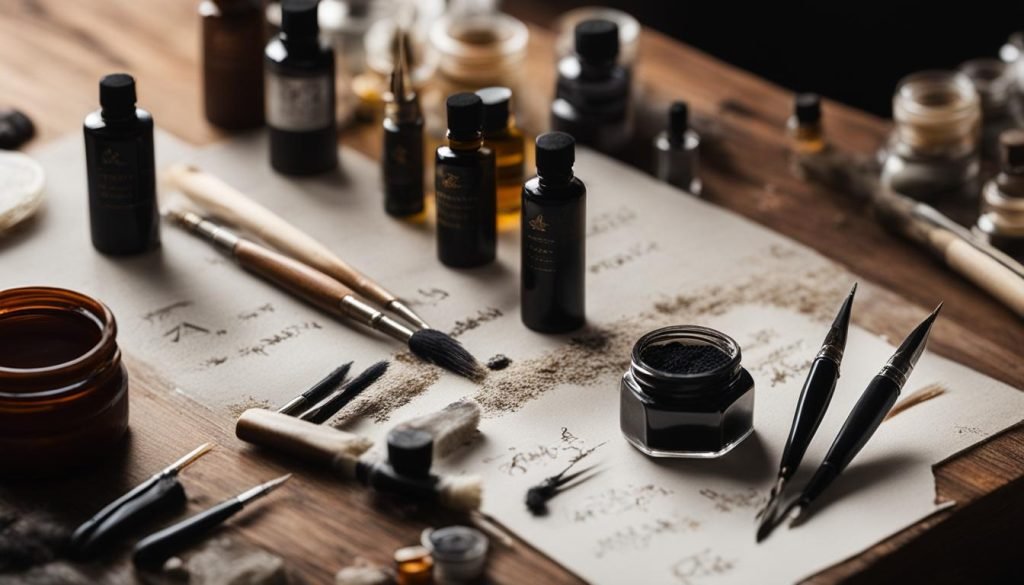
Maintaining the ink for your calligraphy set is crucial for achieving optimal performance in your writing. The consistency of the ink can greatly impact the flow and quality of your strokes, so it’s important to take proper care of it. Here are some tips to help you maintain your ink:
- Adjust the consistency: Thin or thick ink can cause issues with your calligraphy set. If the ink is too thin, it may rush off the nib, requiring constant re-dipping. If it’s too thick, it may stick to the nib and hinder smooth writing. To adjust the consistency, you can add a small quantity of gum arabic to thicken it or distilled water to thin it. Experiment with different ink formulas to find the one that works best for your writing style and preferences.
- Proper storage: Storing your ink properly is essential for maintaining its quality. Make sure to keep the ink bottle tightly closed when not in use to prevent evaporation and contamination. Store it in a cool, dry place away from direct sunlight to preserve its color and consistency.
- Regularly clean your nibs: Ink residue can accumulate on the nibs over time, affecting the ink flow and quality of your writing. Cleaning your nibs regularly using water or a mild cleaning solution can help remove dried ink and maintain optimal performance.
By following these tips, you can ensure that your ink remains in good condition and provides you with smooth, consistent writing. Remember to experiment with different inks and techniques to find what works best for you and enhances your calligraphy skills.
| Tip | Description |
|---|---|
| Adjust the consistency | Thin or thick ink can affect the performance of your calligraphy set. Experiment with adding gum arabic or distilled water to achieve the desired consistency. |
| Proper storage | Store your ink in a cool, dry place away from direct sunlight to maintain its color and consistency. |
| Regularly clean your nibs | Clean your nibs regularly to remove ink residue and ensure optimal ink flow. |
Remember that the quality of your ink plays a significant role in the final outcome of your calligraphy. Take the time to properly maintain and care for your ink, and you’ll be rewarded with beautiful, flawless writing.
Choosing the Right Paper for Calligraphy
When it comes to calligraphy, the choice of paper plays a crucial role in the quality of your work. The right paper can enhance your writing experience, while the wrong paper can cause ink bleeding, feathering, and other undesirable effects. To ensure beautiful and precise calligraphy, it’s important to choose the right paper that complements your calligraphy set. Here are some tips for selecting the perfect paper:
- Opt for smooth and high-quality paper: Smooth paper, such as Rhodia or marker paper, is ideal for dip pens as it allows the ink to flow smoothly and reduces feathering. Look for paper specifically designed for calligraphy or fountain pen use.
- Avoid absorbent paper: Absorbent paper tends to cause ink to feather and bleed. It quickly absorbs ink, resulting in less defined lines and smudges. Avoid using papers like newsprint or low-quality notebook paper.
- Experiment with different types of paper: Different calligraphers have different preferences, so it’s worth experimenting with different types of paper to find the one that works best for your style. Some calligraphers prefer textured paper for a unique visual effect, while others prefer ultra-smooth paper for crisp lines.
By choosing the right paper, you’ll be able to achieve clean and precise calligraphy strokes, allowing your artistry to shine through.
Image source: https://seowriting.ai/32_6.png
| Paper Type | Features |
|---|---|
| Rhodia Paper | Smooth surface, reduces feathering and bleeding, ink dries quickly. |
| Marker Paper | Non-absorbent, ideal for dip pens, minimal ink bleeding. |
| Textured Paper | Provides a unique visual effect, adds character to calligraphy. |
| Ultra-Smooth Paper | Ensures crisp and clean lines, precise calligraphy strokes. |
Proper Storage of Your Calligraphy Set

Proper storage of your calligraphy set is crucial for maintaining its condition and ensuring its longevity. By following a few simple steps, you can protect your pens, nibs, and ink from damage and keep them ready for your next creative session.
1. Choose a Clean and Dry Environment
When storing your calligraphy set, it’s important to select a clean and dry location. Avoid areas that are prone to dampness or humidity, as this can cause ink to spoil and nibs to rust. A dedicated drawer or a sealed container will provide protection from dust, moisture, and other potential hazards.
2. Use Pen Cases or Pouches
To safeguard your pens from scratches and accidental damage, consider using pen cases or pouches. These protective holders help keep your calligraphy set organized and prevent nibs from bending or breaking. Look for cases with individual compartments to separate different nibs and pens, preventing them from coming into contact and causing damage.
3. Avoid Extreme Temperatures
Extreme temperatures can have detrimental effects on your calligraphy set. Avoid exposing your pens to direct sunlight or extreme heat, as it can cause materials to warp or fade. Similarly, storing your set in a cold environment may cause ink to thicken or nibs to become brittle. Maintaining a moderate temperature will help preserve the quality of your tools.
By following these storage practices, you can protect your calligraphy set and ensure that it remains in excellent condition for years to come. Remember to clean your pens and nibs before storing them to remove any ink residue that may cause clogs or damage. With proper care and storage, your calligraphy set will always be ready to inspire your artistic endeavors.
| Storage Tips | Benefits |
|---|---|
| Choose a clean and dry environment | Prevents ink spoilage and nib rust |
| Use pen cases or pouches | Protects pens from scratches and damage |
| Avoid extreme temperatures | Preserves material quality |
Troubleshooting Common Calligraphy Problems
Calligraphy, a beautiful art form that requires skill and precision, can sometimes present challenges. Whether you’re a beginner or an experienced calligrapher, it’s important to know how to troubleshoot common problems that may arise. By understanding the causes and implementing the right solutions, you can overcome these obstacles and continue creating stunning calligraphy pieces.
Problem: Bad Ink Flow
If you’re experiencing uneven or inconsistent ink flow, it can be frustrating and affect the quality of your work. The most common causes of this problem are clogged nibs or dried ink residue. To solve this issue, you can try soaking the nib in warm water or using a specialized nib cleaner to remove any built-up ink. Additionally, make sure to clean your nibs regularly to prevent future clogs.
Problem: Feathering or Bleeding
Feathering and bleeding occur when the ink spreads or seeps into the surrounding paper fibers, resulting in blurred lines and a less defined appearance. To minimize feathering and bleeding, it’s important to choose the right paper that has a smooth surface and is specifically designed for calligraphy. Testing different types of paper with your preferred inks can help you identify the most compatible combination.
Problem: Lack of Stroke Variation
Creating visual interest and depth in calligraphy requires the ability to produce different stroke widths. If you’re struggling with a lack of stroke variation, it may be due to improper pressure control or the wrong nib choice. Practice applying varying degrees of pressure to your nib while maintaining a consistent grip. Additionally, experimenting with different nib styles can help you achieve the desired stroke variation.
Problem: Nib Catching or Scratching on Paper
If your nib is catching or scratching on the paper, it can make it difficult to achieve smooth, uninterrupted lines. This issue often occurs when the nib is worn out or damaged. Check your nib for any signs of wear or irregularities, and replace it if necessary. Additionally, ensure that you’re holding your pen at the correct angle and applying the right amount of pressure to avoid unnecessary friction.
Problem: Fibers or Threads Getting Caught in the Nib
Fibers or threads getting stuck in the nib can disrupt your writing flow and leave unwanted marks on your paper. To prevent this problem, make sure to work on a clean and lint-free surface. Keep an eye out for any loose threads or fibers that may be present on your paper or in your workspace. Using a lint-free cloth or brush to gently remove any debris from your nib can help prevent further issues.
| Problem | Cause | Solution |
|---|---|---|
| Bad Ink Flow | Clogged nibs or dried ink residue | Soak the nib in warm water or use a nib cleaner; clean nibs regularly |
| Feathering or Bleeding | Ink spreading or seeping into paper fibers | Choose smooth calligraphy paper designed to minimize feathering and bleeding |
| Lack of Stroke Variation | Improper pressure control or wrong nib choice | Practice pressure control and experiment with different nib styles |
| Nib Catching or Scratching | Worn out or damaged nib | Check and replace the nib if necessary; hold the pen at the correct angle |
| Fibers or Threads in Nib | Loose threads or fibers on paper or workspace | Work on a clean surface; remove debris from the nib with a lint-free cloth or brush |
By addressing these common calligraphy problems and implementing the appropriate solutions, you can overcome challenges and continue your calligraphy journey with confidence. Remember, practice and patience are key to mastering this beautiful art form. Keep honing your skills, and enjoy the beauty and elegance of calligraphy.
A Brief History of Calligraphy Pens
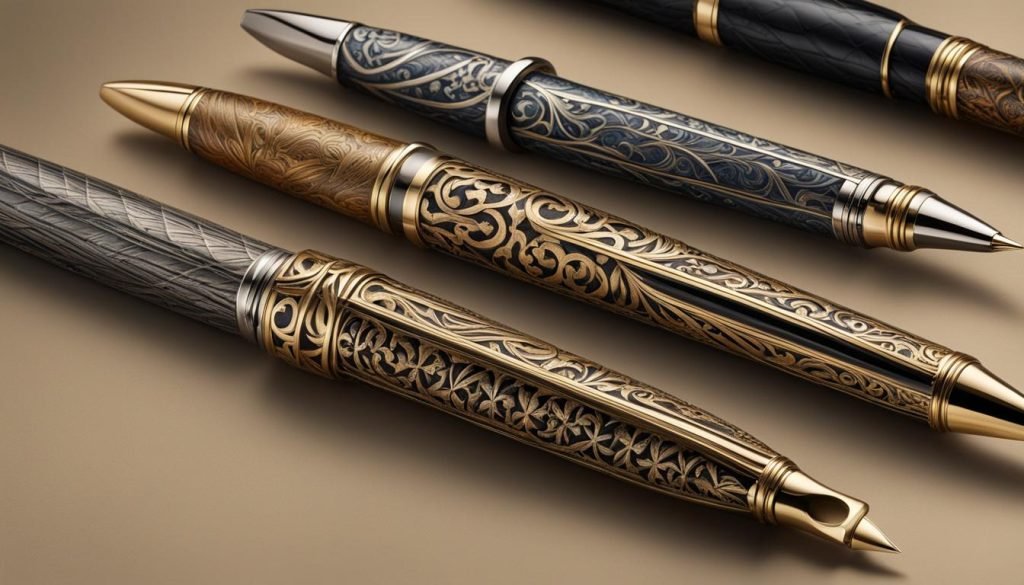
Calligraphy pens have a long and rich history that spans centuries and civilizations. The art of calligraphy itself dates back to ancient Egypt, where scribes used reed pens to create beautiful hieroglyphic inscriptions. These early writing instruments laid the foundation for the development of more sophisticated pens in later times.
During the Middle Ages, quill pens made from the feathers of birds became the go-to writing tool for calligraphers. These pens allowed for more intricate and precise strokes, enabling the creation of elaborate scripts and designs. The quill pen remained popular well into the 19th century, even as new writing instruments began to emerge.
One of the most significant advancements in calligraphy pen technology was the invention of the dip pen. This pen, introduced in the 19th century, featured a metal nib that could be dipped into ink, allowing for a continuous flow of ink onto the paper. Dip pens revolutionized calligraphy, providing greater control and versatility for artists.
The Evolution of Calligraphy Pens
As the art of calligraphy evolved, so did the pens used to create it. In the early 20th century, fountain pens gained popularity among calligraphers. These pens used a reservoir of ink and a feed system to deliver ink to the nib, eliminating the need to dip the pen continuously. Fountain pens offered a smoother and more convenient writing experience.
Today, calligraphy pens come in various forms and designs, catering to different artistic styles and preferences. Modern fountain pens with flexible nibs allow for expressive and dynamic strokes, while marker pens provide a more convenient option for lettering and casual calligraphy. There are also digital calligraphy pens that can be used on tablets and other digital devices, opening up new possibilities for calligraphers in the digital age.
Influential Pen Manufacturers
Over the years, several pen manufacturers have made significant contributions to the development and popularity of calligraphy pens. Brands like Montblanc, Parker, Waterman, and Pelikan have become synonymous with quality and craftsmanship. These manufacturers continue to produce high-quality pens that are sought after by calligraphers and pen enthusiasts around the world.
The history of calligraphy pens is a testament to the enduring appeal of this art form and the ingenuity of those who continue to push the boundaries of pen design. Whether you prefer traditional dip pens or modern fountain pens, the right calligraphy pen can help you unlock your creativity and bring your artistic vision to life.
Types of Collectible Pens
Collectible pens offer a world of variety when it comes to style and craftsmanship. Whether you’re a seasoned collector or just starting out, understanding the different types of collectible pens can enhance your appreciation for these exquisite writing instruments.
Fountain Pens
Fountain pens are often considered the epitome of pen craftsmanship. They feature a nib that draws ink from a reservoir and provides a smooth and continuous flow. Fountain pens offer a unique writing experience, allowing for different ink colors and nib sizes to suit your personal style and preferences. They are prized by collectors for their elegance and timeless appeal.
Ballpoint Pens
Ballpoint pens are a popular choice for everyday writing due to their convenience and reliability. They use a small ball bearing to dispense ink onto the paper, resulting in a consistent and smooth writing experience. Ballpoint pens come in a wide range of designs, from sleek and minimalist to bold and eye-catching, making them a versatile option for both collectors and everyday users.
Rollerball Pens
Rollerball pens offer the best of both worlds, combining the smoothness of a fountain pen with the convenience of a ballpoint pen. They use a water-based liquid ink that flows more freely than ballpoint ink, resulting in a smoother and more expressive writing experience. Rollerball pens are favored by those who appreciate the fluidity and precision of a fountain pen but prefer the convenience of a ballpoint.
| Pen Type | Description |
|---|---|
| Fountain Pens | Feature a nib that draws ink from a reservoir, offering a unique writing experience. |
| Ballpoint Pens | Use a small ball bearing to dispense ink, making them convenient for everyday use. |
| Rollerball Pens | Offer a smooth and expressive writing experience with the convenience of a ballpoint pen. |
Collectible pens come in various styles to suit different preferences.
Fountain pens are often considered the pinnacle of pen craftsmanship, while ballpoint pens and rollerball pens offer convenience and versatility.
In addition to these pen types, collectors often seek out vintage pens for their historical value and unique characteristics. Vintage pens can provide a glimpse into the craftsmanship and design trends of different eras, making them highly sought after by collectors.
When it comes to materials, collectible pens can be crafted from a wide range of options. From precious metals like gold and silver to exotic woods and vibrant resins, each material adds its own allure and aesthetic appeal to the pen. Some collectors even pursue pens made from unconventional materials like carbon fiber or mother-of-pearl, showcasing the creativity and innovation of pen makers.
Whether you’re drawn to the classic elegance of a fountain pen, the practicality of a ballpoint pen, or the smoothness of a rollerball pen, the world of collectible pens offers endless possibilities for pen enthusiasts. Explore different styles, materials, and types to build your own unique collection and experience the artistry of these timeless writing instruments.
Materials Used in Collectible Pens
When it comes to collectible pens, the materials used in their construction play a crucial role in their value and desirability among pen enthusiasts. From precious metals to exotic woods and innovative composites, these materials add a unique touch to each pen, making it a work of art in its own right.
1. Precious Metals
Many collectible pens are crafted from precious metals like gold and silver, which not only give the pens a luxurious appearance but also contribute to their durability and longevity. The use of these metals adds value to the pen and makes it a highly sought-after item for collectors.
2. Exotic Woods
Exotic woods, with their distinct grains and natural beauty, are also popular choices for crafting collectible pens. Woods like rosewood, ebony, and olive wood are often used to create unique and aesthetically pleasing designs. The warmth and character of these materials can elevate the pen’s overall appeal.
3. Resins and Acrylics
Resins and acrylics offer a wide range of colors and patterns, making them versatile options for creating visually striking collectible pens. These materials can be crafted into intricate designs, showcasing vibrant swirls or shimmering metallic finishes. Pens made from resin or acrylic often have a modern and eye-catching look.
Collectible pens can also feature unconventional materials that add a touch of novelty and uniqueness. Carbon fiber, known for its lightweight and strength, and materials like dinosaur fossils, provide collectors with pens that are truly one-of-a-kind.
Whether it’s the elegance of precious metals, the natural beauty of exotic woods, or the artistic possibilities of resins and acrylics, the materials used in the construction of collectible pens contribute to their allure and desirability. Each pen becomes a testament to the craftsmanship and passion of its maker, making it a cherished item for pen enthusiasts and collectors alike.
Conclusion
Proper maintenance and care of your calligraphy set are essential for achieving the best results and prolonging the lifespan of your tools. By following a few simple steps, you can ensure that your calligraphy set remains in pristine condition and ready to create beautiful works of art whenever inspiration strikes.
Regularly cleaning your nibs is a crucial part of calligraphy set maintenance. This helps maintain good ink flow and prevents clogs, ensuring smooth and consistent writing. Additionally, adjusting the consistency of your ink by adding gum arabic or distilled water can greatly enhance your writing experience.
Choosing the right paper for your calligraphy also plays a vital role in maintaining your set. Smooth, high-quality paper reduces feathering and bleeding, allowing you to achieve clean and precise lines. Experiment with different types of paper to find the one that best suits your calligraphy style.
Finally, proper storage is key to ensuring the longevity of your calligraphy set. Keep your pens in a clean and dry environment, using cases or pouches to protect them from dust and scratches. Separating different nibs and pens in individual compartments can prevent damage and maintain their overall condition.
FAQ
Why is regular maintenance important for my calligraphy set?
Regular maintenance ensures optimal performance and prolongs the lifespan of your tools.
How do I clean my nibs?
You can clean nibs by wiping them with rubbing alcohol, using non-abrasive toothpaste and a soft toothbrush, passing them through a flame, or immersing them in boiling water.
How can I adjust the consistency of the ink?
You can adjust the consistency of the ink by adding a small quantity of gum arabic to thicken it or distilled water to thin it.
What type of paper is best for calligraphy?
Smooth, high-quality paper, such as Rhodia or marker paper, is ideal for dip pens as it absorbs ink slowly and reduces feathering and bleeding.
How should I store my calligraphy set?
Store your pens in a clean and dry environment, use pen cases or pouches to protect them from dust and scratches, and consider separating different nibs and pens in individual compartments.
What are some common calligraphy problems and their solutions?
Common problems include bad ink flow, feathering or bleeding, lack of stroke variation, nib catching or scratching on paper, and fibers or threads getting caught in the nib. Each issue has specific solutions, such as preparing new nibs, cleaning nibs regularly, using different nibs for specific ink flow preferences, adjusting grip, and using lint-free towels when cleaning nibs.
What is the history of calligraphy pens?
Calligraphy pens have a rich history that dates back centuries, from reed pens used by ancient Egyptians to quill pens in medieval times and the invention of dip pens and fountain pens.
What are the types of collectible pens?
Collectible pens come in various styles, including fountain pens, ballpoint pens, rollerball pens, and vintage pens.
What materials are used in collectible pens?
Collectible pens can be crafted from materials such as precious metals, exotic woods, resin, acrylics, carbon fiber, and even unique materials like dinosaur fossils.
Why is proper maintenance important for my calligraphy set?
Proper maintenance and care of your calligraphy set are essential for achieving the best results and prolonging the lifespan of your tools.


